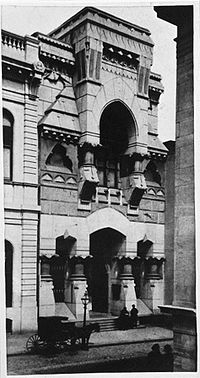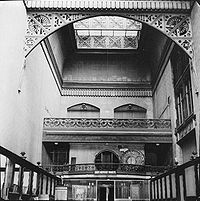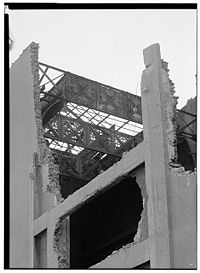
Provident Life & Trust Company
Encyclopedia
The Provident Life & Trust Company in Philadelphia, Pennsylvania
, a demolished Victorian-era building by architect Frank Furness
, is considered to have been one of his greatest works. A bank and insurance company founded in 1865 by members of the Society of Friends (Quakers), the Provident's L-shaped building had entrances at 409 Chestnut Street (bank) and 42 South 4th Street (insurance company). The two wings were eventually consolidated into an office building (also by Furness) at the northwest corner of 4th & Chestnut Streets.
 In his Brazilian Pavilion at the 1876 Centennial Exposition, and his Centennial National Bank
In his Brazilian Pavilion at the 1876 Centennial Exposition, and his Centennial National Bank
(1876) at 32nd St. & Lancaster Ave., Furness experimented with architectural features that would become part of his distinctive design vocabulary: unorthodox stone massing; revealing (and even highlighting) structure; compressed, piston-like columns; polychromy, all in a Moorish-influenced Modern Gothic style. The Provident Life & Trust Company was a major breakthrough for Furness, and remained vibrant even after later additions, interior and exterior, seriously compromised its power.
 The bank at 409 Chestnut Street was to be part of Philadelphia's "Banker's Row", and the challenge was to distinguish it from the established Italianate buildings. Furness won the Provident commission in a national design competition in 1876, besting his former partner George Hewitt. His forceful Modern Gothic facade demanded attention, its projecting bay and tower balanced on compressed columns, themselves supported by corbels (brackets) jutting out from the building. The whole was a study in tension and compressed energy, heavy, but not looming.
The bank at 409 Chestnut Street was to be part of Philadelphia's "Banker's Row", and the challenge was to distinguish it from the established Italianate buildings. Furness won the Provident commission in a national design competition in 1876, besting his former partner George Hewitt. His forceful Modern Gothic facade demanded attention, its projecting bay and tower balanced on compressed columns, themselves supported by corbels (brackets) jutting out from the building. The whole was a study in tension and compressed energy, heavy, but not looming.
The interior was one enormous room, its 4-story walls and floor covered with multi-colored Minton tiles, an arched iron truss at mid-building decorated with machine-inspired cutouts, and skylights supported by iron trusses with similar cutouts. The front half was lit by the great Gothic window of the facade's projecting bay and a large skylight; the rear half, by another skylight and clerestory windows facing north. Rear windows from the insurance company on 4th Street opened into the tall light-filled banking room. The effect was more church-like than secular—a shrine to commerce—with a severity and logic that presaged the Chicago School
of early-20th century modernism.
 Almost immediately, Furness's original vision was compromised as the company expanded. Within a couple years, a low, curved balcony was added at the rear, and another at the front beneath the great Gothic window, accessed by a spiral staircase to the banking floor and later from the building to the east. The bank was expanded north to Ranstead Street, the clerestory windows blocked, and a second balcony added at the rear. By 1888, the Provident had bought up all the adjacent properties to the east, and hired Furness, Evans & Company to build a 10-story office building.
Almost immediately, Furness's original vision was compromised as the company expanded. Within a couple years, a low, curved balcony was added at the rear, and another at the front beneath the great Gothic window, accessed by a spiral staircase to the banking floor and later from the building to the east. The bank was expanded north to Ranstead Street, the clerestory windows blocked, and a second balcony added at the rear. By 1888, the Provident had bought up all the adjacent properties to the east, and hired Furness, Evans & Company to build a 10-story office building.
Furness's Provident Building (1888–90) was a disappointment, a busy Bavarian fantasy attached to a model of creative rationalism. On its lower stories, he replicated the polychromatic materials of the bank and echoed the Gothic arch, but mostly the office building was ponderous and pretentious. Its steep, 3-story red-tile roof was matched by a new pyramidical roof for the bank's tower—a duncecap on what had been the brightest student. The office building's 1945 demolition (and the removal of the duncecap) enabled architects to look at the original bank anew.
(1819–24), a white-marble, Greek Revival temple by William Strickland
. Planning for what is now Independence National Historical Park
(INHP) began in the late-1940s, and Strickland's bank was to become an art museum housing portraits of the Founding Fathers. On the block opposite Furness's bank, every building except the Second Bank was demolished for the national park, and a re-creation of William Thornton
's Library Company of Philadelphia
(1790) was erected. The sedate Italianate buildings of Banker's Row were considered harmonious with the Second Bank and the re-created Library Hall; the Provident was considered jarring.
 Through the 1950s, architectural historians worked to save Furness's bank, writing articles for major publications, photographing and documenting it. Charles E. Peterson
Through the 1950s, architectural historians worked to save Furness's bank, writing articles for major publications, photographing and documenting it. Charles E. Peterson
, the National Park Service
architect assigned to INHP, edited a column in the Journal of the Society of Architectural Historians
and used it to call attention to the Provident. But, in the end, the Colonial Revivalists remained unswayed, and Furness's bank was demolished beginning in 1959. Samples of the Minton tiles and other architectural elements are preserved in the architecture study collection at INHP.
In essence, the brash, Look-At-Me!-quality that had won Furness the Provident commission was the very reason for the building's demolition. Architectural historian Henry-Russell Hitchcock
eulogized it in 1963:
Pennsylvania
The Commonwealth of Pennsylvania is a U.S. state that is located in the Northeastern and Mid-Atlantic regions of the United States. The state borders Delaware and Maryland to the south, West Virginia to the southwest, Ohio to the west, New York and Ontario, Canada, to the north, and New Jersey to...
, a demolished Victorian-era building by architect Frank Furness
Frank Furness
Frank Heyling Furness was an acclaimed American architect of the Victorian era. He designed more than 600 buildings, most in the Philadelphia area, and is remembered for his eclectic, muscular, often idiosyncratically scaled buildings, and for his influence on the Chicago architect Louis Sullivan...
, is considered to have been one of his greatest works. A bank and insurance company founded in 1865 by members of the Society of Friends (Quakers), the Provident's L-shaped building had entrances at 409 Chestnut Street (bank) and 42 South 4th Street (insurance company). The two wings were eventually consolidated into an office building (also by Furness) at the northwest corner of 4th & Chestnut Streets.
Creation

Centennial National Bank
-History:The bank was chartered on January 19, 1876 to finance the Centennial Exposition.The bank's headquarters building, designed by noted Philadelphia architect Frank Furness, was completed in April 1876. The building's interior was modified in 1893, and again in 1899, when Philadelphia...
(1876) at 32nd St. & Lancaster Ave., Furness experimented with architectural features that would become part of his distinctive design vocabulary: unorthodox stone massing; revealing (and even highlighting) structure; compressed, piston-like columns; polychromy, all in a Moorish-influenced Modern Gothic style. The Provident Life & Trust Company was a major breakthrough for Furness, and remained vibrant even after later additions, interior and exterior, seriously compromised its power.

The interior was one enormous room, its 4-story walls and floor covered with multi-colored Minton tiles, an arched iron truss at mid-building decorated with machine-inspired cutouts, and skylights supported by iron trusses with similar cutouts. The front half was lit by the great Gothic window of the facade's projecting bay and a large skylight; the rear half, by another skylight and clerestory windows facing north. Rear windows from the insurance company on 4th Street opened into the tall light-filled banking room. The effect was more church-like than secular—a shrine to commerce—with a severity and logic that presaged the Chicago School
Chicago school (architecture)
Chicago's architecture is famous throughout the world and one style is referred to as the Chicago School. The style is also known as Commercial style. In the history of architecture, the Chicago School was a school of architects active in Chicago at the turn of the 20th century...
of early-20th century modernism.
Compromise

Furness's Provident Building (1888–90) was a disappointment, a busy Bavarian fantasy attached to a model of creative rationalism. On its lower stories, he replicated the polychromatic materials of the bank and echoed the Gothic arch, but mostly the office building was ponderous and pretentious. Its steep, 3-story red-tile roof was matched by a new pyramidical roof for the bank's tower—a duncecap on what had been the brightest student. The office building's 1945 demolition (and the removal of the duncecap) enabled architects to look at the original bank anew.
Demolition
Across Chestnut Street from the Furness bank was the Second Bank of the United StatesSecond Bank of the United States
The Second Bank of the United States was chartered in 1816, five years after the First Bank of the United States lost its own charter. The Second Bank of the United States was initially headquartered in Carpenters' Hall, Philadelphia, the same as the First Bank, and had branches throughout the...
(1819–24), a white-marble, Greek Revival temple by William Strickland
William Strickland (architect)
William Strickland , was a noted architect in nineteenth-century Philadelphia, Pennsylvania and Nashville, Tennessee.-Life and career:...
. Planning for what is now Independence National Historical Park
Independence National Historical Park
Independence National Historical Park is a United States National Historical Park in Philadelphia that preserves several sites associated with the American Revolution and the nation's founding history. Administered by the National Park Service, the park comprises much of the downtown historic...
(INHP) began in the late-1940s, and Strickland's bank was to become an art museum housing portraits of the Founding Fathers. On the block opposite Furness's bank, every building except the Second Bank was demolished for the national park, and a re-creation of William Thornton
William Thornton
Dr. William Thornton was a British-American physician, inventor, painter and architect who designed the United States Capitol, an authentic polymath...
's Library Company of Philadelphia
Library Company of Philadelphia
The Library Company of Philadelphia is a non-profit organization based in Philadelphia, Pennsylvania. Founded by Benjamin Franklin as a library, the Library Company of Philadelphia has accumulated one of the most significant collections of historically valuable manuscripts and printed material in...
(1790) was erected. The sedate Italianate buildings of Banker's Row were considered harmonious with the Second Bank and the re-created Library Hall; the Provident was considered jarring.

Charles E. Peterson
Charles Emil Peterson is widely considered to be a seminal figure in professionalizing the practice of historic preservation in the United States...
, the National Park Service
National Park Service
The National Park Service is the U.S. federal agency that manages all national parks, many national monuments, and other conservation and historical properties with various title designations...
architect assigned to INHP, edited a column in the Journal of the Society of Architectural Historians
Society of Architectural Historians
The Society of Architectural Historians is an international not-for-profit organization that promotes the study and preservation of the built environment worldwide....
and used it to call attention to the Provident. But, in the end, the Colonial Revivalists remained unswayed, and Furness's bank was demolished beginning in 1959. Samples of the Minton tiles and other architectural elements are preserved in the architecture study collection at INHP.
In essence, the brash, Look-At-Me!-quality that had won Furness the Provident commission was the very reason for the building's demolition. Architectural historian Henry-Russell Hitchcock
Henry-Russell Hitchcock
Henry-Russell Hitchcock was the leading American architectural historian of his generation. A long-time professor at Smith College and New York University, he is best known for writings that helped to define Modern architecture.-Biography:...
eulogized it in 1963:
Still more original and impressive were his banks, even though they lay quite off the main line of development of commercial architecture in this period. The most extraordinary of these, and Furness's masterpiece, was the Provident Institution in Walnut [sic. Chestnut] Street, built as late as 1879. This was most unfortunately demolished in the Philadelphia urban renewal campaign several years ago, but the gigantic and forceful scale of the granite membering alone should have justified its respectful preservation. The interior, entirely lined with patterned tiles, was of rather later character than the facade and eventually much cluttered with later intrusions, but it was equally fine in its own way originally.

